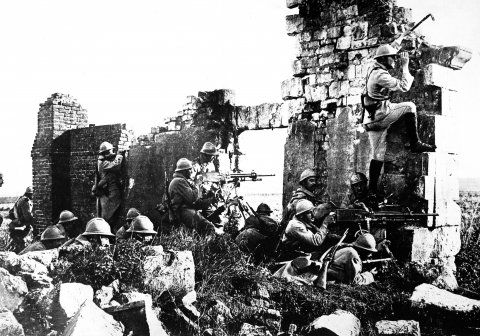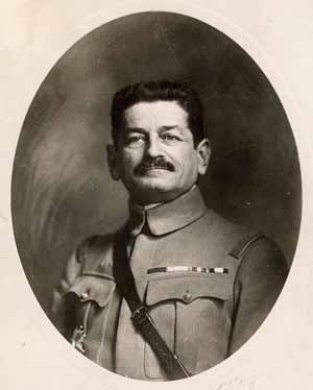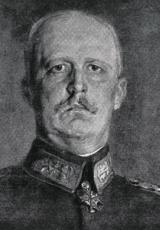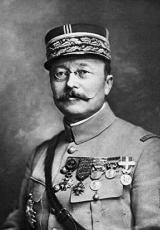1918: the Second Battle of the Marne (27 May - 6 August)

Following the signing of the Treaty of Brest-Litovsk, on 3 March 1918, Germany hastened to transfer its troops from Russia to France. Now with numerical superiority over its British, French and Belgian adversaries, in order to secure victory it had to launch a series of offensives before the Americans arrived at the front.
On 21 March 1918, Ludendorff launched the first of five German spring offensives against the French and British armies near Amiens. Disaster was only just averted, and the Germans were stopped six miles outside Amiens. On 9 April, the German general launched his second offensive against British troops in Flanders. Despite the violence of the fighting and Germany’s superior numbers, the imperial army failed to make a breakthrough.
The Marne
On 27 May 1918, the third offensive got under way. It was disastrous for the French army, and is generally known as the “French Caporetto”. The 1st and 7th Imperial German Armies, with fire support from thousands of guns, launched an attack on the French front from Vauxaillon to Reims, held by the Fifth and Sixth Armies.
The Germans crossed the ridges of the Chemin des Dames to reach the Aisne at Soupir at 10 am. By 8 pm, they had reached the Vesle at Bazoches, driving back General Duchêne’s Sixth Army, which was in disarray. On the 28th, the battle developed. The enemy took Fismes. The following day, they conquered Soissons to the west, Fère-en-Tardenois in the centre, and the Saint-Thierry massif to the east, advancing through the Ardre Valley towards Montagne de Reims. By the 30th, the Germans had made it to the Marne at Jaulgonne, Dormans and Château-Thierry.
To the southwest of Soissons, the Battle of Crise broke out at Vauxbuin and Courmelles, which were defended by General Daugan’s Moroccan Infantry Division. In this sector, at Chaudun, 31 May saw the first engagement of Renault FT tanks of the 201st Assault Artillery Regiment. In the eastern section of the offensive, the Fifth Army engaged in fierce fighting as far as the inner suburbs of Reims. Colonial troops (metropolitan marine infantry, Senegalese riflemen) and the Army of Africa defended the city without yielding any ground, so that this pivotal salient of the French front remained intact. On 4 June, there was violent fighting all along the pocket carved out by the enemy: at Corcy and Faverolles; on the Clignon, at Veuilly-la-Poterie and Belleau Wood; on the Marne, at Château-Thierry and Hill 204, defended by marine infantry and US troops; on Montagne de Reims, at Bligny, where French, British and Italians vied with each other in courage; and at Reims, where the Germans made no headway.

French troops under General Gouraud, with their machine guns positioned in the ruins of a church near the Marne, drive back the German attack. 1918. Source: U.S. Federal Government
Foch and Pétain, well informed, in particular by aerial reconnaissance, organised the defence. The Ninth Army (under General de Mitry) was sent in first. From 10 to 29 June, the 2nd US Infantry Division and the marines recaptured Belleau Wood. On 1 July, the Americans reconquered the village of Vaux, then, on the 9th, Hill 204. Meanwhile, to the southwest of Reims, on Hill 240 and Montagne de Bligny, the 2nd Colonial Infantry Division and the Italian 2nd Army Corps (under General Albricci) halted the enemy.
On the 12th, the Germans attacked in force at Corcy, Longpont and Saint-Pierre-Aigle, where they failed. On the 18th, they attacked the Reims salient once again, from Vrigny to Fort de la Pompelle, with no notable result other than heavy losses. Everywhere, the French units fought tooth and nail. On 15 July, the 7th Imperial Army crossed the Marne to advance towards Épernay.
Codenamed Friedensturm, this was the fifth German offensive against the Champagne front (the fourth, which was contained, having begun on 9 June on the Matz). The Americans kept them out of the Surmelin Valley, while the French put up stubborn resistance. The following day, the enemy advance was checked. The pontoon bridges laid across the Marne were attacked and destroyed by Allied air forces (French and British) and heavy artillery, cutting off German supplies.
The Allied counter-offensive
Foch prepared a large-scale response, designed to take back the initiative, in operations which began on 18 July. General Mangin concentrated his resources (2 000 guns and 345 tanks, supported by 500 aircraft) in the forest of Villers-Cotterêts. His 18 divisions (one Scots, two American and 15 French) battered the flank of the German 7th and 8th Armies, advancing six miles into the Soissonnais area and taking 10 000 prisoners.

General Mangin. Photo: SHAT
General Degoutte launched his nine divisions (six French and three American) with 147 tanks towards the south bank of the Ourcq, and advanced three miles. On the 20th, he recaptured Château-Thierry, where Clemenceau arrived the next day to congratulate the troops. The Germans clung to the Crise, with Mangin on their heels. Threatened with being surrounded, on the night of the 19th they evacuated the south bank of the Marne, with the Fifth Army in pursuit.
The French offensive progressed towards the Vesle. On the 28th, the French took Fère-en-Tardenois and the Scots Buzancy. On 2 August, the light infantry of the 2nd Battalion of Chasseurs à Pied entered Soissons, and the Fifth Army Ville-en-Tardenois. On 4 August, the 28th US Infantry Division recaptured Fismes, after fierce street fighting. Everywhere, the enemy was driven back over the Vesle.
In three weeks, the French armies and their Allies took 35 000 prisoners, captured 700 guns and liberated 200 villages. On 6 August, Foch was promoted to the rank of Marshal of France. On 8 August, a new offensive between Morlancourt and Braches inflicted an unprecedented setback on the German army: in Ludendorff’s own words, it was a “day of mourning for the German army”.
200 000 French soldiers were killed, wounded or went missing in these operations, in the period of 15 to 31 July alone. But the Second Battle of the Marne, and in particular the Allied counter-offensive of 18 July, was unquestionably a first important step on the road to victory.





